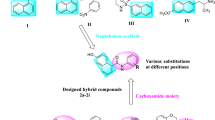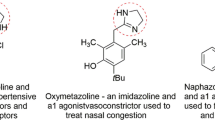Abstract
Novel thiono and seleno phosphoramidate compounds with the general formula (X)(Y)P(C6H5)2; (X = NMe2 & Y = S, 1a; X = NEt2 & Y = S, 2a; X = NMe(CH2Ph) & Y = S, 3a; X = NH(CH2Ph) & Y = S, 4a; X = NEt(CH2Ph) & Y = S, 5a; X = N(C(Me)3) (CH2Ph) & Y = S, 6a; X = N(CH2Ph)2 & Y = S, 7a; X = NMe2 & Y = Se, 1b; X = NEt2 & Y = Se, 2b; X = NMe(CH2Ph) & Y = Se, 3b; X = NH (CH2Ph) & Y = Se, 4b; X = NEt(CH2Ph) & Y = Se, 5b; X = N(C(Me)3)(CH2Ph) & Y = Se, 6b and X = N(CH2Ph)2 & Y = Se, 7b) were prepared and characterized by 1H, 31P and 13C NMR and IR spectroscopy and elemental analysis. 31P chemical shift of thiono and seleno derivatives didn’t show significant different because of their little difference in electronegativity sulfur and selenium. Hydrophobic parameter of compounds was determined by measurement of octanol-water partition coefficient by shake-flask technique. Determination of human erythrocyte acetylcholinesterase (hAChE) activity was carried out according to the Ellman’s modified kinetic method. IC50 values of the selected thiono and seleno compounds varied from 3.4 to 0.11 and 9.9 to 5.1 mM, respectively. The seleno compounds show lower affinities for hAChE relative to the thino compounds. These results demonstrate that hydrophobic and electronic factors of the organophosphorus compounds play a key role on the inhibitory potency.
Similar content being viewed by others
References
Cohen SD, Williams RA, Killinger JM, Freudenthal RI (1985) Comparative sensitivity of bovine and rodent acetylcholinesterase to in␣vitro inhibition by organophosphate insecticides. Toxicol Appl Pharmacol 83:452–459
Pardio VT, Ibarra N, Rodriguez MA (2001) Use of cholinesterase activity in monitoring organophosphate pesticide exposure of cattle produced in tropical areas. J Agric Food Chem 9:6057–6052
Quistad GB, Zhang N, Sparks SE, Casida JE (2000) Phosphoacetylcholinesterase: toxicity of phosphorus oxychloride to mammals and insects that can be attributed to selective phosphorylation of acetylcholinesterase by phosphorodichloridic acid. Chem Res Toxicol 13:652–657
Mallender WD, Szegletes T, Rosenberry TL (2000) Acetylthiocholine binds to Asp74 at the peripheral site of human acetylcholinesterase at the first step in the catalytic pathway. Biochem 39:7753–7763
Massoulie J, Pezzementi L, Bon S, Krejci E, Vallette FM (1993) Molecular and cellular biology of cholinesterases, prog. Neurobiol 41:31–91
Casale GP, bavari S, Connolly J (1989) Inhibition of human serum complements activity by diisopropylfluorophosphates and selected anticholinestrase insecticides. Fundam Appl Toxicol 12:460–468
Jokanovic M, Maksimovic M, Kilibarda V, Jovanovic D, Savic D (1996) Qxime-induced reactivation of acetylcholinesterase inhibited by phosphoramidates. Toxicol Lett 85:35–39
Vilanova E, Johnson MK, Vicedo JL (1987) Interaction of some unsubstituted phosphoramidate analogs of methamidophos (O, S-dimethyl phosphorothioamidate) with acetylcholinesterase and neuropathy target esterase of hen brain. Pestic Biochem Physiol 28:224–238
Maxwell DM, Brecht KM (1992) Quantitative structure-activity analysis of acetylcholinesterase inhibition by oxono and thiono analogs of organophosphorus compounds. Chem Res Toxicol 5:66–71
Thompson CM, Frick JA, Natke BC, Hansen LK (1989) Preparetion, analysis and anticholinesterase properties of O, O-dimethyl phosphorothioate isomerides. Chem Res Toxicol 2:386–391
Yang H-Z, Zhang Y-J, Wang L-X, Tan H-F, Cheng M-R, Xing X-D, Chen R-Y, Fujita T (1986) Quantitative structure-activity study of herbicidal O-aryl O-ethyl N-isopropylphosphoramidothioates Pesticide. Biochem Physiol 26:275–283
Segall Y, Quistad GB, Sparks SE, Casidaet JE (2003) Major intermediates in organophosphate synthesis (PCl3, POCl3, PSCl3, and their diethyl esters) are anticholinesterase agents directly or on activation. Chem Res Toxicol 16:350–356
Ryu S, Lin J, Thompson CM (1991) Comparative anticholinesterase potency of chiral isoparathion methyl. Chem Res Toxicol 4:517–520
Metcalf RL, Francis BM, Metcalf RA, Farage-Elawar M, Hansen LG (1988) Structure- activity relationships in the acute and delayed neurotoxicity of methyl- and etylphosphonothionates. Pestic Biochem Physiol 30:46–56
Levi PE, Hollingworth RM, Hodgson E (1998) Differences in oxidative dearylation and desulfurration of fenitrothion by cytochrome p−450 isozymes and in the subsequent inhibition of monooxygenase activity. Pestic Biochem Physiol 32:224–231
Lee H, Kim YA, Cho YA, Lee YT (2002) Oxidation of organophosphorus pesticides for the sensitive detection by a cholinesterase-based biosensor. Chemosphere 46:571–576
Casida JE (1964) Esterase inhibitors as pesticides. Science 146:1011–1017
Chevykalova MN, Manzhukova LF, Artemova NV, Luzikov YN, Nifant’ev IE, Nifant’ev EE (2003) Electron-donating ability of triarylphosphines and related compounds studied by P-31 NMR spectroscopy. Russ Chem Bull 52:78–84
Pilioni G, Longato B, Bandoli G (1999) Variable coordination modes for 1,1′-bis(diphenylphosphino) ferrocene (dppf) mono- and di-chalcogenides or-oxides (dppfE and dppfE2, E = O, S or Se) in copper(1) complexes. crystal structure of [{Cu(dppf)}2 (Ix-dppfS2)](BF4)2 and [ Cu(dppfSe)2]BF4. Inorg Chim Acta 277:163–170
Bhattacharyya P, Slawin AMZ, Woollins JD (2001) Bridge cleavage of [{PhP(Se)(μ-Se)}2] by 1,2-C6H4(EH)(E′H) (E, E′ = O or NH). X-ray crystal structure of PhP(Se)(NHC6H4NH-1,2). J Organomet Chem 623:116–119
Rudd MD, Creighton MA, Kautz JA (2004) Synthesis and characterization of chalcogenoic aminophosphines: X-ray structures of Bu2P(E)NHPr (E = Se, Te), Ph2P(Se)NHPr and {Et2P(Se)}2NPr, Polyhedron 23:1923–1929
Venkatakrishnan TS, Krishnamurthy SS, Nethaji M (2005) Chalcogen-capped ruthenium carbonyl clusters derived from diphosphazane mono- and dichalcogenides of the type X2P(E)N(R)PX2 and X2P(E)N (R)P(E)X2 (E = S or Se). J Organomet Chem 690:4001–4017
Bayandina EV, Nuretdinov IA, Nurmukhamedova LV (1978) Synthesis of arylselenophosphinic acid derivatives and their properties. J Gen Chem USSR 48:2673–2677
Cupertino D, Birdsall DJ, Slawin AMZ (1999) The preparation and coordination chemistry of iPr2P(E)NHP(E′)iPr2 (E, E′ = Se, E = Se, E′ = S, E = S, E′ = O, E,E′ = O. Inorg Chim Acta 290:1–7
Schultz TW, Cronin MTD, Walker JD, Aptula AO (2003) Quantitative structure–activity relationships (QSARs) in toxicology: a historical perspective. J Mol Struct (Theochem), 622: 1–22
Karelson M, Lobanov VS, Katritzky AR (1996) Quantum-chemical descriptors in QSAR/QSPR studies. Chem Rev 96:1027–1044
Lewis DF V (2004) Quantitative structure–activity relationships (QSARs) for substrates of human cytochromes P450 CYP2 family enzymes. Toxicol In Vitro 18:89–97
Hansch C, Steinmetz WE, Leo AJ, Mekapati SB, Kurup A, Hoekman D (2003) On the role of polarizability in chemical-biological interactions. J Chem Inf Comput Sci 43:120–125
Hansch C, Dunn W (1972) Linear relationships between lipophilic chatacter and biological activity of drugs. J Pharm Sci-Us 61:1–19
Henchman RH, Tai K, Shen T, MaCammon JA (2002) Properties of water molecules in the active site gorge of acetylcholinesterase from computer simulation. Biophys J 82:2671–2682
Doorn JA, Gage DA, Schall M, Talley TT, Thompson CM, Richardson RJ (2000) Inhibition of acetylcholinesterase by (1S,3S)-isomalathion proceeds with loss of thiomethyl: kinetic and mass spectral evidence for an unexpected primary leaving group. Chem Res Toxicol 13:1313–1320
Barak D, Ordentlich A, Kaplan D, Barak R, Mizrahi D, Kronman C, Segall Y, Velan B, Shafferman A (2000) Evidence for P-N bond scission in phosphoroamidate nerve agent adducts of human acetylcholinesterase. Biochem 39:1156–1161
Tompson CM, Suarez AI, Rodriguez OP (1996) Synthesis and 31P chemical shift identification of tripeptide active site models that represent human serum acetylcholinesterase covalently modified at serine by certain organophosphates. Chem Res Toxicol 9:1325–1332
Corbridge DEC (1995) Phosphorus, an outline of its chemistry, biochemistry and technology. 5th edn. Elsevier, The Netherlands
Ellman GL, Courinfy KD, Andress V, Featherstone RM (1961) A new and rapid colorimetric determination of acethylcholinesterase activity. Biochem Pharmacol 7:88–95
Lee BH, Stelly TC, Colucci WJ, Garcia GJ, Gandour RD, Quinn DM (1992) Inhibition of acetylcholinesterase by hemicholiniums, conformationally constrained choline analogs. Evaluation of aryl and alkyl substituents. Comparisons with choline and (3-hydroxyphenyl)trimethylammonium. Chem Res Toxicol 5:411–418
Acknowledgements
S.D. would like to acknowledge the Alzahra University Research Council for partial support of this work. The authors are pleased to thank Professor Issa Yavari (Tarbiat Modarres University, Iran) for insightful NMR discussions.
Author information
Authors and Affiliations
Corresponding author
Rights and permissions
About this article
Cite this article
Dehghanpour, S., Rasmi, Y. & Bagheri, M. Structure-toxicity relationships of thiono and seleno phosphoramidate compounds: new type of acetylcholinesterase inhibitors. Mol Divers 11, 47–57 (2007). https://doi.org/10.1007/s11030-007-9056-6
Received:
Accepted:
Published:
Issue Date:
DOI: https://doi.org/10.1007/s11030-007-9056-6




